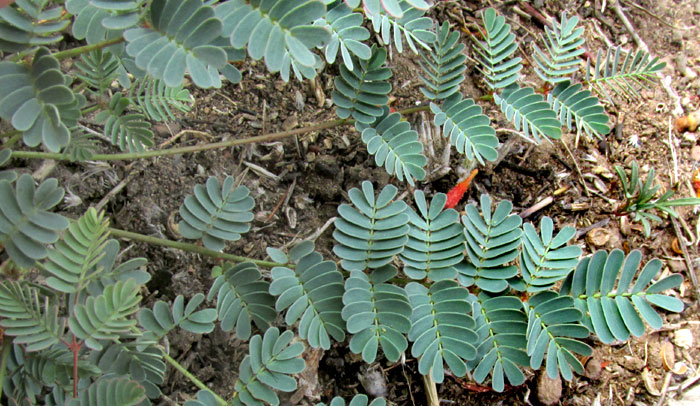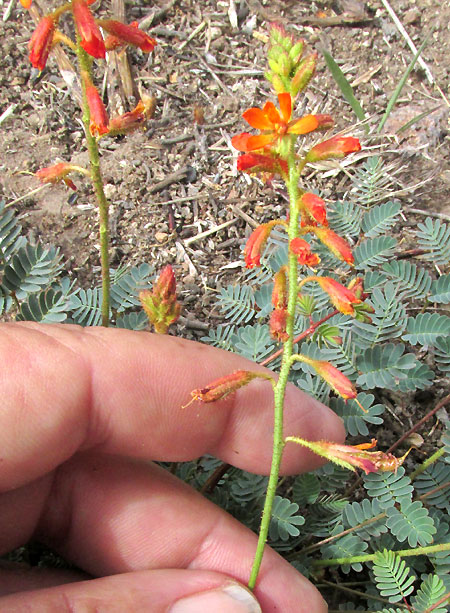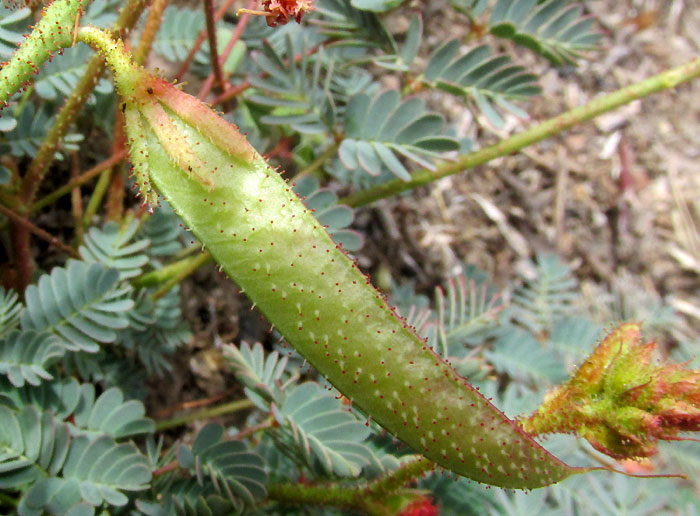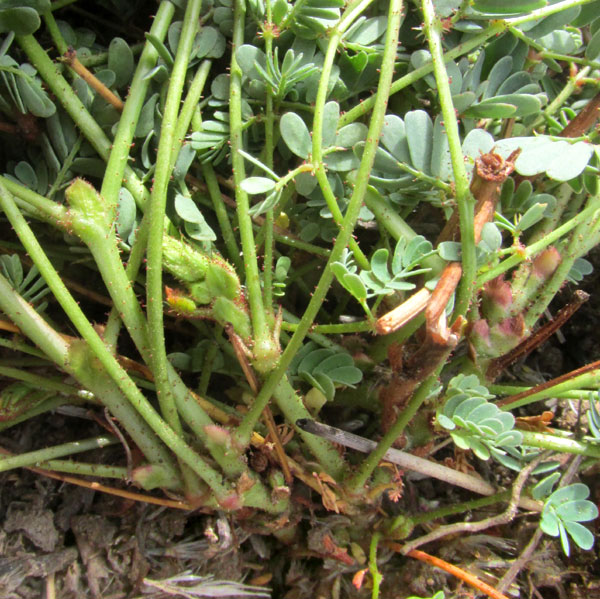Excerpts from Jim Conrad's
Naturalist Newsletter
entry dated July 15, 2022, issued from near Tequisquiapan, elevation about 1,900m (6200 ft), N20.565°, W99.890°, Querétaro state, MÉXICO
HOFFMANNSEGGIA OXYCARPA subsp. ARIDA

On a grossly overgrazed, yearly burned, eroding, rocky slope of dirt developed from hard-compacted sediment from nearby hills composed of igneous rhyolite rock, the manhole-cover-size perennial bush shown above seemed to be thriving.
Various species of prickly, woody shrubs bearing feathery, twice-pinnately compound leaves inhabited the same slope, members of the Mimosa Tribe of the big Bean or Legume Family, the Fabaceae, and this plant's leaves looked like one of those:

The leaves' petioles were unusually long relative to the length of the leafy part, and the leaves' color was a little bluish. When the flowers were examined up close, another surprise was that the flowers weren't the kind the Mimosa Tribe produces; they were more like those of the Caesalpinia Tribe, which explains the color, similar to that of blossoms of the Royal Poinciana, which also belongs to that tribe:

The panicle-type inflorescence indicated that this plant gets its flowering and fruiting done in a hurry, for at the top there were flower buds, below them just one or two open flowers, then below them the already-pollinated blossoms became increasingly wilted, and the bottom flower has a legume-type fruit emerging from among petal remains.

The flower seen from the front displays a top petal marked with red spots on a yellow-orange background, like you can see in Royal Poinciana flowers, and the cluster of stamens angles downward, surely to accommodate pollinators. However, the most striking feature may be the many thick-stalked, gland-tipped hairs covering the stem, the sepals and even the bottoms of the petals. Usually such glands discourage plant-eating invertebrates.

From the side, the bowing stamens and glandular hairs are even more striking.

The immature legumes also were densely covered with glandular hairs. The plant's many long-petioled leaves and long-peduncled inflorescences, but no apparent branches, seemed unusual, so some leaves were lifted and the base was photographed:

Very short stems did arise from a knotty but apparently herbaceous base. Probably this form is an adaptation for surviving frequent grazing livestock and burnings. If the herbage is destroyed, the base can quickly sprout again and maybe flower and fruit before the next onslaught.
Once I was "doing the botany," it was surprising to learn that this plant belongs to a genus I'd never heard of: Hoffmannseggia, named in honor of the Count of Hoffmannsegg, a German nobleman and botanist of the 1800s.
According to the 2006 publication of Beryl B. Simpson and Emilio A. Ulibarri entitled "A Synopsis of the Genus Hoffmannseggia (Leguminosae)," the genus consists of 22 species, half in North America, in which he includes Mexico, and half in South America. Using Simpson's keys, our plants work out to be HOFFMANNSEGGIA OXYCARPA subsp. ARIDA, in the whole world endemic only to the semiarid areas of here in central Querétaro state and the neighboring state of Hidalgo. Another subspecies, ssp. oxycarpa, occurs in southern Texas and the contiguous Mexican states of Coahuila, Nuevo León and Tamaulipas, but the two subspecies are widely separated by most of northern Mexico.
So, there you go. You're an old man stumbling around in a goat-ravaged, cinderized, eroding, abandoned field in Mexico when out of the blue the Count of Hoffmannsegg catches your eye, his orangish-yellow panache waving in the wind.